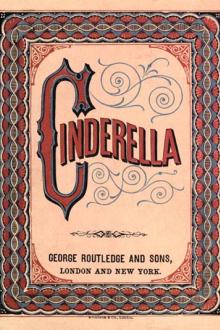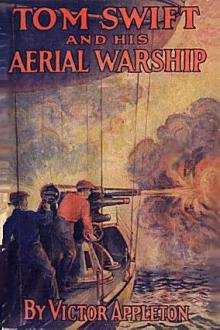Tom Swift and His Submarine Boat by Howard R. Garis (best e reader for manga TXT) 📕

While father and son were deep in a discussion of the apparatus of the submarine, there will be an opportunity to make the reader a little better acquainted with them. Those of you who have read the previous volumes of this series do not need to be told who Tom Swift is. Others, however, may be glad to have a proper introduction to him.
Tom Swift lived with his father, Barton Swift, in the village of Shopton, New York. The Swift home was on the outskirts of the town, and the large house was surrounded by a number of machine shops, in which father and son, aided by Garret Jackson, the engineer, did their experimental and constructive work. Their house was not far from Lake Carlopa, a fairly large body of water, on which Tom often speeded his motor-boat.
In the first volume of this series, entitled "Tom Swift and His Motor-Cycle," it was told how he became acquainted with Mr. Wakefield Damon, who suffered an accident while riding one of the speedy machines. The accident disgus
Read free book «Tom Swift and His Submarine Boat by Howard R. Garis (best e reader for manga TXT) 📕» - read online or download for free at americanlibrarybooks.com
- Author: Howard R. Garis
- Performer: -
Read book online «Tom Swift and His Submarine Boat by Howard R. Garis (best e reader for manga TXT) 📕». Author - Howard R. Garis
But it was too late. Above them they could hear the electric siren of the Wonder as it was blown to let them know that their escape had been noticed. A moment later the water, which acted as a sort of sounding-board, or telephone, brought to the ears of Tom Swift and his friends the noise of the engines of the other craft in operation. She was coming after them. The race for the possession of three hundred thousand dollars in gold was already under way. Fate seemed against those on board the Advance.
Directed by Captain Weston, who glanced at the compass and told him which way to steer to clear the outer coral reef, Tom sent the submarine ahead, signaling for full speed to the engine-room, where his father and Mr. Sharp were. The big dynamos purred like great cats, as they sent the electrical energy into the forward and aft plates, pulling and pushing the Advance forward. On and on she rushed under water, but ever as she shot ahead the disturbance in the phosphorescent water showed her position plainly. She would be easy to follow.
“Can’t you get any more speed out of her?” asked the captain of the lad.
“Yes,” was the quick reply; “by using the auxiliary screws I think we can. I’ll try it.”
He signaled for the propellers, forward and aft, to be put in operation, and the motor moving the twin screws was turned on. At once there was a perceptible increase to the speed of the Advance.
“Are we leaving them behind?” asked Tom anxiously, as he glanced at the speed gage, and noted that the submarine was now about five hundred feet below the surface.
“Hard to tell,” replied the Captain. “You’d have to take an observation to make sure.”
“I’ll do it,” cried the youth. “You steer, please, and I’ll go in the conning tower. I can look forward and aft there, as well as straight up. Maybe I can see the Wonder.”
Springing up the circular ladder leading into the tower, Tom glanced through the windows all about the small pilot house. He saw a curious sight. It was as if the submarine was in a sea of yellowish liquid fire. She was immersed in water which glowed with the flames that contained no heat. So light was it, in fact, that there was no need of the incandescents in the tower. The young inventor could have seen to read a paper by the illumination of the phosphorus. But he had something else to do than observe this phenomenon. He wanted to see if he could catch sight of the rival submarine.
At first he could make out nothing save the swirl and boiling of the sea, caused by the progress of the Advance through it. But suddenly, as he looked up, he was aware of some great, black body a little to the rear and about ten feet above his craft.
“A shark!” he exclaimed aloud. “An immense one, too.”
But the closer he looked the less it seemed like a shark. The position of the black object changed. It appeared to settle down, to be approaching the top of the conning tower. Then, with a suddenness that unnerved him for the time being, Tom recognized what it was; it was the underside of a ship. He could see the plates riveted together, and then, as he noted the rounded, cylindrical shape, he knew that it was a submarine. It was the Wonder. She was close at hand and was creeping up on the Advance. But, what was more dangerous, she seemed to be slowly settling in the water. Another moment and her great screws might crash into the Conning tower of the Swifts’ boat and shave it off. Then the water would rush in, drowning the treasure-seekers like rats in a trap.
With a quick motion Tom yanked over the lever that allowed more water to flow into the ballast tanks. The effect was at once apparent. The Advance shot down toward the bottom of the sea. At the same time the young inventor signaled to Captain Weston to notify those in the engine-room to put on a little more speed. The Advance fairly leaped ahead, and the lad, looking up through the bull’s-eye in the roof of the conning tower, had the satisfaction of seeing the rival submarine left behind.
The youth hurried down into the interior of the ship to tell what he had seen, and explain the reason for opening the ballast tanks. He found his father and Mr. Sharp somewhat excited over the unexpected maneuver of the craft.
“So they’re still following us,” murmured Mr. Swift. “I don’t see why we can’t shake them off.”
“It’s on account of this luminous water,” explained Captain Weston. “Once we are clear of that it will be easy, I think, to give them the slip. That is, if we can get out of their sight long enough. Of course, if they keep close after us, they can pick us up with their searchlight, for I suppose they carry one.”
“Yes,” admitted the aged inventor, “they have as strong a one as we have. In fact, their ship is second only to this one in speed and power. I know, for Bentley & Eagert showed me some of the plans before they started it, and asked my opinion. This was before I had the notion of building a submarine. Yes, I am afraid we’ll have trouble getting away from them.”
“I can’t understand this phosphorescent glow keeping up so long,” remarked Captain Weston. “I’ve seen it in this locality several times, but it never covered such an extent of the ocean in my time. There must be changed conditions here now.”
For an hour or more the race was kept up, and the two submarines forged ahead through the glowing sea. The Wonder remained slightly above and to the rear of the other, the better to keep sight of her, and though the Advance was run to her limit of speed, her rival could not be shaken off. Clearly the Wonder was a speedy craft.
“It’s too bad that we’ve got to fight them, as well as run the risk of lots of other troubles which are always present when sailing under water,” observed Mr Damon, who wandered about the submarine like the nervous person he was. “Bless my shirt-studs! Can’t we blow them up, or cripple them in some way? They have no right to go after our treasure.”
“Well, I guess they’ve got as much right as we have,” declared Tom. “It goes to whoever reaches the wreck first. But what I don’t like is their mean, sneaking way of doing it. If they went off on their own hook and looked for it I wouldn’t say a word. But they expect us to lead them to the wreck, and then they’ll rob us if they can. That’s not fair.”
“Indeed, it isn’t,” agreed Captain Weston, “if I may be allowed the expression. We ought to find some way of stopping them. But, if I’m not mistaken,” he added quickly, looking from one of the port bull’s-eyes, “the phosphorescent glow is lessening. I believe we are running beyond that part of the ocean.”
There was no doubt of it, the glow was growing less and less, and ten minutes later the Advance was speeding along through a sea as black as night. Then, to avoid running into some wreck, it was necessary to turn on the searchlight.
“Are they still after us?” asked Mr. Swift of his son, as he emerged from the engine-room, where he had gone to make some adjustments to the machinery, with the hope of increasing the speed.
“I’ll go look,” volunteered the lad. He climbed up into the conning tower again, and for a moment, as he gazed back into the black waters swirling all about, he hoped that they had lost the Wonder. But a moment later his heart sank as he caught sight, through the liquid element, of the flickering gleams of another searchlight, the rays undulating through the sea.
“Still following,” murmured the young inventor. “They’re not going to give up. But we must make ‘em—that’s all.”
He went down to report what he had seen, and a consultation was held. Captain Weston carefully studied the charts of that part of the ocean, and finding that there was a great depth of water at hand, proposed a series of evolutions.
“We can go up and down, shoot first to one side and then to the other,” he explained. “We can even drop down to the bottom and rest there for a while. Perhaps, in that way, we can shake them off.”
They tried it. The Advance was sent up until her conning tower was out of the water, and then she was suddenly forced down until she was but a few feet from the bottom. She darted to the left, to the right, and even doubled and went back over the course she had taken. But all to no purpose. The Wonder proved fully as speedy, and those in her seemed to know just how to handle the submarine, so that every evolution of the Advance was duplicated. Her rival could not be shaken off.
All night this was kept up, and when morning came, though only the clocks told it, for eternal night was below the surface, the rival gold-seekers were still on the trail.
“They won’t give up,” declared Mr. Swift hopelessly.
“No, we’ve got to race them for it, just as Berg proposed,” admitted Tom. “But if they want a straightaway race we’ll give it to ‘em Let’s run her to the limit, dad.”
“That’s what we’ve been doing, Tom.”
“No, not exactly, for we’ve been submerged a little too much to get the best speed out of our craft. Let’s go a little nearer the surface, and give them the best race they’ll ever have.”
Then the race began; and such a contest of speed as it was! With her propellers working to the limit, and every volt of electricity that was available forced into the forward and aft plates, the Advance surged through the water, about ten feet below the surface. But the Wonder kept after her, giving her knot for knot. The course of the leading submarine was easy to trace now, in the morning light which penetrated ten feet down.
“No use,” remarked Tom again, when, after two hours, the Wonder was still close behind them. “Our only chance is that they may have a breakdown.”
“Or run out of air, or something like that,” added Captain Weston. “They are crowding us pretty close. I had no idea they could keep up this speed. If they don’t look out,” he went on as he looked from one of the aft observation windows, “they’ll foul us, and—”
His remarks were interrupted by a jar to the Advance. She seemed to shiver and careened to one side. Then came another bump.
“Slow down!” cried the captain, rushing toward the pilot house.
“What’s the matter?” asked Tom, as he threw the engines and electrical machines out of gear. “Have we hit anything?”
“No. Something has hit us,” cried the captain. “Their submarine has rammed us.”
“Rammed us!” repeated Mr. Swift. “Tom, run out the electric cannon! They’re trying to sink us! We’ll have to fight them. Run out the stern electric gun and we’ll make them wish they’d not followed us.”
There was much excitement aboard the Advance. The submarine came to a stop in the water, while the treasure-seekers waited anxiously for what was to follow. Would they be rammed again? This time, stationary as they were, and with the other boat coming swiftly on, a hole might be





Comments (0)